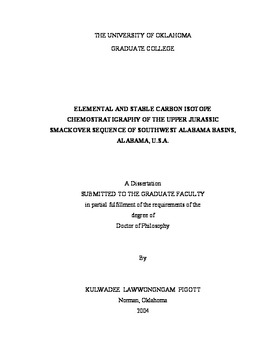| dc.contributor.advisor | Philp, Richard P., | en_US |
| dc.contributor.author | Pigott, Kulwadee Lawwongngam. | en_US |
| dc.date.accessioned | 2013-08-16T12:19:35Z | |
| dc.date.available | 2013-08-16T12:19:35Z | |
| dc.date.issued | 2004 | en_US |
| dc.identifier.uri | https://hdl.handle.net/11244/812 | |
| dc.description.abstract | The sequence stratigraphy of the Upper Jurassic (Oxfordian) Smackover marine carbonate sequence was investigated from a chemostratigraphic analysis of samples of the Conecuh Embayment and the Manila Embayment of southwest Alabama, Gulf Coast of the United States. The analytical approaches were based upon an integration of core descriptions, petrography of thin sections, elemental compositions, oxygen and stable carbon isotopes from carbonate and organic materials. The results demonstrate the effectiveness of using stable carbon isotope chemostratigraphy for a ramp sequence stratigraphic model which allows possible local and global stratigraphic correlations. | en_US |
| dc.description.abstract | During the Oxfordian, core and petrographic data indicated that the Smackover depositions in the southwest Alabama basins occurred in different depositional environments and diagenetic conditions related to the structural setting and paleotopography. Early carbonate deposition took place in the Conecuh Embayment, although in partially restricted conditions owing to basement highs, as low-energy, restricted lagoonal to shallow marine conditions. The mudstone, algal mudstone and peloidal, pelletoid wackestones are dominant from the lower to middle Smackover and show small relative diagenetic changes into stable diagenetic calcite. In the upper Smackover, increasing depositional energy and an open less restricted connection to normal marine waters permitted the deposition of high energy oolitic packstone and grainstones of a barrier-shoal environment. Changes of the original carbonate phase associated with changing subsurface environmental conditions increased diagenesis. The shallower structural setting of the Manila Embayment affected pervasive dolomitization of sediment deposited under a tidal shallow water environment. The shallowing-upward cycles are dominated by intertidal mudstone and wackestone "ribbon rock". Dark organic-rich subtidal sediments commonly overlie the anhydritic dolostone of the previous cycle. In the upper Smackover, intercalation between siliciclastic sandstone and carbonate intervals revealed similar increasing depositional energy. During the Smackover sequence, siliciclastic sediment interruptions occurred, but are only distinctive in the sediment from Conecuh Embayment owing to a higher siliciclastic background which was present in the Manila Embayment. However, subaerial exposure superimposed on the dolomitized upper intertidal to supratidal sediments is detectable. Based upon a carbonate ramp stratigraphic model, the variation between carbonate-siliciclastic sedimentation and variable Smackover facies are interpreted to record the variations of relative sea level cycles, depositional environment and paleowater-depth conditions. (Abstract shortened by UMI.) | en_US |
| dc.format.extent | xxii, 273 leaves : | en_US |
| dc.subject | Smackover Formation. | en_US |
| dc.subject | Geology, Stratigraphic Jurassic. | en_US |
| dc.subject | Sequence stratigraphy. | en_US |
| dc.subject | Geology. | en_US |
| dc.subject | Facies (Geology) Alabama. | en_US |
| dc.title | Elemental and stable carbon isotope chemostratigraphy of the Upper Jurassic Smackover sequence of southwest Alabama basins, Alabama, United States. | en_US |
| dc.type | Thesis | en_US |
| dc.thesis.degree | Ph.D. | en_US |
| dc.thesis.degreeDiscipline | Conoco Phillips School of Geology and Geophysics | en_US |
| dc.note | Source: Dissertation Abstracts International, Volume: 65-10, Section: B, page: 5040. | en_US |
| dc.note | Adviser: Richard P. Philp. | en_US |
| ou.identifier | (UMI)AAI3150967 | en_US |
| ou.group | Mewbourne College of Earth and Energy::Conoco Phillips School of Geology and Geophysics | |
